Abstract
In this design, foam packaging for consumer products is replaced by the kraft paper cushioning system. The kraft paper is made into a cylindrical structure, with small cylindrical structures pasted to its outer walls. The cylindrical structure can withstand a high amount of stress, internally and externally. These cylindrical structures’ center points make an imaginary equilateral triangle. Therefore, the applied load is distributed equally across the cylinders and hexagonal structures. We can replace foam packaging with this kraft paper packaging. This design is expected to provide a more eco-friendly product than a normal packaging system. The interior design for the kraft paper is created as integrated cylindrical structures designed using Computer Aided Drawing (CAD). Various tests, such as on compression, impact, and vibration, were carried out. In this design, stimulation, cost comparison of the design, and manufacturing feasibility were examined.
1. Introduction
A cushioning system is introduced to avoid damage caused due to forces acting on the surface during transportation. Package cushioning keeps products safe during shipping by absorbing the forces acting on them, ensuring the products stay undamaged. Its main role is to avoid impacts and make sure that the transportation of the product is safe. Transportation is carried out using a corrugated box with a cushioning system. Generally, foam is used for cushioning systems. It is designed to absorb shock by crushing and deforming. In the late 1900s, air cushioning technology was introduced in which each unit trapped air molecules inside a durable urethane shell. Cushioning materials are the important factor for cushioning systems, as they are responsible for absorbing shock, distributing pressure, and providing comfort. These materials are designed to deform under load, dissipating energy and reducing the impact felt by users or objects. Commonly used materials for packaging are foam and its alternatives, gel, air, rubber materials, composite materials, and so on. Kraft paper cushioning is a packaging material designed to protect items during transportation. It consists of layers of shredded kraft paper, which is a type of strong, resilient paper made from wood pulp. Also, kraft paper cushioning is a versatile, lightweight, and eco-friendly packaging solution that provides effective protection for fragile items while offering benefits in terms of cost and sustainability [1]. A multi-layered corrugated paperboard has been designed to deliver superior resistance to harsh impacts and accidental drops, ensuring better protection for the contents [2]. An investigation has been made into how relative humidity influences the mechanical performance of a sandwich structure made from corrugated cardboard [3]. The shock-absorbing ability of corrugated fiberboard relies on the cushion’s size, even when the product’s static load on the cushion remains unchanged. During the dynamic compression of fiberboard pads, air pressure accumulates within the cushion, enhancing its overall cushioning efficiency [4]. A proposed experimental approach aims to determine the in-plane elastic properties of both the individual components and the corrugated cardboard, while analyzing the influence of geometric parameters on these properties [5]. This emphasizes the box compression process and the significance of box compression testing, revisiting previous research to offer valuable context for ongoing studies [6]. The FEM model of the package, incorporating this new element, effectively predicts experimental incipient buckling data from standard box compression tests, all while requiring minimal computational effort and using only a few degrees of freedom [7]. It presents analytical approaches for evaluating the static vertical compressive strength of basic corrugated packaging, taking into account the torsional and shear rigidity of the corrugated material, along with the ratio of panel depth to width [8]. Ventilation and hand holes reduce material on two or more sides of the box, weakening its compression strength necessary for shipping and stacking, potentially leading to damaged contents. Additionally, inadequately reinforced hand holes can pose safety risks during manual handling. Traditional packaging materials, such as foam (commonly made from polyurethane and similar plastics), are widely used in cushioning systems. These materials have effective shock absorption and load distribution properties. Foam materials pose environmental issues: they are non-biodegradable, resource-intensive due to petroleum-based inputs, and difficult to recycle, often ending up in landfills. The proposed kraft paper cushioning system offers a sustainable alternative. Made from renewable wood fibers, kraft paper is biodegradable, recyclable, and strong. Its cylindrical design enhances shock absorption and load distribution while remaining eco-friendly, making it a viable replacement for foam.
2. Purpose of Cushioning
A cushioning system serves several purposes across various applications, from footwear to packaging to furniture design. The main purpose of cushioning systems is to absorb and dissipate impact forces, protecting delicate items from damage during transportation. Cushioning systems provide a protective barrier against external forces, preventing damage to the products. In packaging, cushioning materials such as foam, bubble wrap, or air cushions safeguard items from bumps, drops, or vibrations during shipping. In products like mattresses, furniture, and seating, cushioning systems enhance comfort by providing a soft and supportive surface for users to sit or lie on. In footwear, cushioning systems improve comfort by reducing pressure points and providing a more cushioned feel underfoot. Some cushioning materials are designed to not only absorb shock but also to return energy, providing a responsive feel. This is particularly important in athletic footwear, where energy return can enhance performance by propelling the wearer forward with each step.
3. Materials of Cushioning Systems
Foam-based cushioning, typically made from polyurethane (C27H36N2O10) and other plastics, significantly pollutes the environment. Replacing foam with kraft paper reduces environmental impact, as it is derived from renewable wood fibers, promoting sustainability. Kraft paper is strong, coarse, and has high tensile strength, making it ideal for industrial and commercial uses. Sack kraft paper, with high elasticity and tear resistance, is suited for packaging demanding strength and durability. Common cushioning materials like foam, bubble wrap, and rubber offer impact absorption but are non-biodegradable, resource-intensive, and carbon-heavy. The kraft paper system addresses these issues with sustainable manufacturing and innovative structural designs, enhancing load-bearing capacity and energy absorption.
4. Properties
Kraft paper is eco-friendly, made from wood pulp using chemicals, heat, and pressure. It is strong, flexible, semi-porous, and easily recyclable, reducing plastic usage. Its durability and tear resistance make it ideal for packaging materials like boxes, bags, and wrapping paper, protecting products during shipping and handling. Kraft paper decomposes quickly compared to plastic, minimizing environmental impact. Its smooth surface allows easy branding or the addition of information. With strength, flexibility, and sustainability, it is widely used across industries for packaging and other applications. Kraft paper, with a density of 70–100 GSM, offers adequate stiffness and durability. It has a tensile strength of 30–50 MPa and an elastic modulus of 1–3 GPa, ensuring resilience and elasticity for shock absorption. Its smooth surface allows easy folding and precise cylindrical shaping without cracking. Additionally, its fibrous structure resists tearing under stress and is fully biodegradable and recyclable, supporting sustainable packaging.
5. Design and Methodology
This cushioning system, designed using CAD (SOLIDWORKS 2019), protects products by stacking layers of hollow cylinders for enhanced cushioning. A 200 × 120 mm base with a 1 mm thickness was created on the top plane. Concentric circles (4 mm outer diameter, 3 mm inner diameter) with a 1 mm thickness were drawn, and cylinders were extended to 120 mm. Using the linear pattern command, successive layers were stacked. Historically, cardboard evolved from simple layered paperboard to corrugated and honeycomb designs for improved load bearing. Drawing from the benefits of fluted and honeycomb structures, this design uses stacked cylindrical flutes. When two layers align, their centers form triangles, while three stacked layers result in a hexagonal pattern, combining structural stability and cushioning efficiency (shown in Figure 1). The cushioning system comprises hollow cylindrical units (5 mm diameter) stacked in three layers to form a dense, stable structure. The cylinders are arranged in a pentagonal pattern, enhancing compression resistance and stress distribution. Each pentagonal cell is 15–16 mm wide, and the total thickness for three 5 mm layers is about 15 mm.

Figure 1.
Interior design structure of cylindrical layers. Blue dashed lines indicate hexagonal shape, while green symbols represent coincident shape.
We aim to evaluate the cushioning efficiency of the cylindrical structure using CAD (SOLIDWORKS 2019) simulation under static conditions. Since the required material was not preloaded, it was customized with appropriate data. To simulate, one part of the model was fixed using a fixed geometry, and an external force was applied. The simulation provided results for stress, displacement, and strain. Stress analysis revealed deformation scale, yield strength, and stress (N/mm2). Displacement indicated thickness reduction, while strain measured material deformation under stress.
6. Experimental Section and Test Setup
A triangular structure of kraft paper is sandwiched between two carboard layers in a normal corrugated box. It can have cushioning effects. Here, we are going to replace the triangular structure with a cylindrical structure, which gives more strength and a better cushioning system than the traditional one. We came up with a model containing a cylindrical structure made from kraft paper layered in between the sheets. It was made of up to three layers (3D designs are shown in Figure 2, Figure 3 and Figure 4). A compression test was performed using a Computerized Universal testing machine, at first on the regular corrugated layer with triangular flutes and then on the newly designed models. The results were graphed, and the strengths were compared. The load bearing capacity, deformation behavior, and compressive strength of the three-layer kraft paper cushioning system were tested using a computational machine with load cells and displacement sensors. The cushioning was placed between flat compression plates for even load distribution. The test used a load rate of 5 mm/min and stopped when complete failure or significant deformation occurred, such as at 50% thickness reduction. Key parameters include observing elastic and plastic deformation, maximum load per unit area (kPa or MPa), and the area under the stress–strain curve. The impact test uses a computational testing machine with a drop-weight impact setup, where a sensor-equipped impactor (flat or hemispherical) drops onto the kraft paper cushion placed on a rigid base. The drop height ranges from 50 cm to 1 m, and the impactor mass is 5–10 kg. The test measures energy absorbed, material compression, and the ability to return to its original shape. For the vibration test, a vibration table with accelerometers is used to measure response, with the cushioning system placed between a mock payload and the table. Parameters include a frequency range of 5–200 Hz, amplitude up to 1.5 mm, and test durations of 1–3 h, simulating vertical and horizontal transport vibrations.
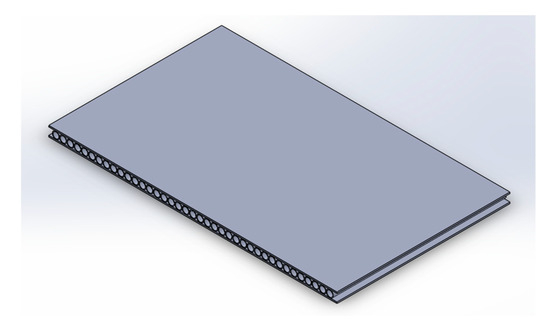
Figure 2.
Single layer of cylinders in sequence.
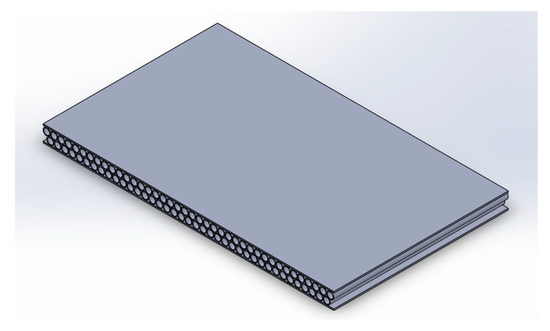
Figure 3.
Double layer of cylinders in sequence.
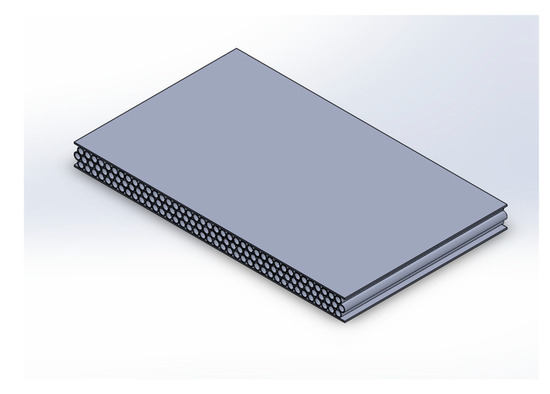
Figure 4.
Triple layer of cylinders in sequence.
6.1. Ordinary Cardboard Box
An ordinary corrugated sheet with triangular flutes was subjected to the compression test. The thickness of the sheet was observed to be 4.4 mm. The loads were gradually applied. The sheet showed initial deformation at 0.4 N and as the load increased, the deformation rate went higher. The sheet was found to tolerate loads up to 5.5 kN. Post-testing, the thickness of the sheet was found to be 3.7 mm (shown in Figure 5 and Figure 6).
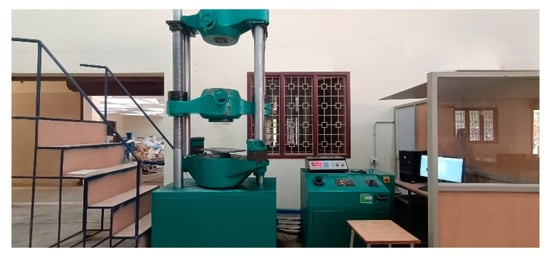
Figure 5.
Computerized universal testing machine.
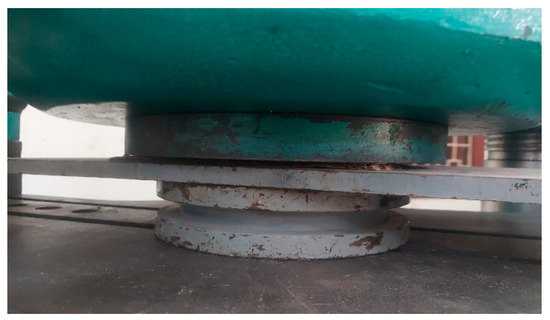
Figure 6.
Compressing images of traditionally used cardboard.
6.2. Type 1: Single-Layered
A single layer of cylinders was pasted on a kraft paper sheet of thickness 1 mm. The overall length and breadth of the model turned out to be 198 mm and 160 mm, respectively, with a thickness of 5 mm. A maximum compressive load of 5.6 kN was tolerable and after deformation, the thickness was 4.8 mm (shown in Figure 7).
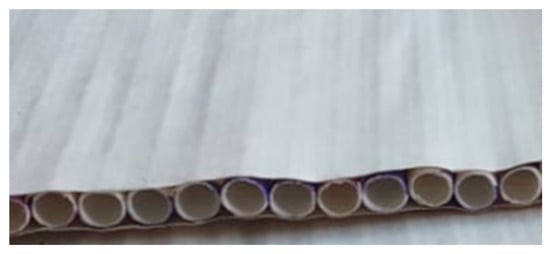
Figure 7.
Experimental setup of the single layer.
6.3. Type 2: Double-Layered
When there are two layers of cylindrical structure placed one above the other, joining their centers gives rise to a triangle. The overall length and breadth of the model remained at 198 mm and 160 mm while the thickness increased to 10 mm. Compressive loads were gradually applied and it was found that the model could withstand up to 6.2 kN, with the thickness reducing to 9.1 mm (shown in Figure 8).
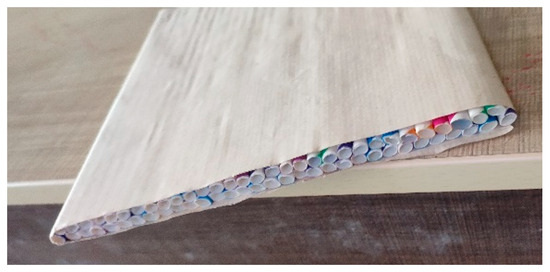
Figure 8.
Experimental setup of the double layer.
6.4. Type 2: Triple-Layered
When there are three layers of cylindrical structures placed one above the other, joining their centers gives rise to a hexagon. The overall length and breadth of the model remained at 198 mm and 160 mm, while the thickness increased to 10 mm. Compressive loads were gradually applied, and it was found that the model could withstand up to 11.10 kN with the thickness reducing to 14.9 mm (shown in Figure 9).
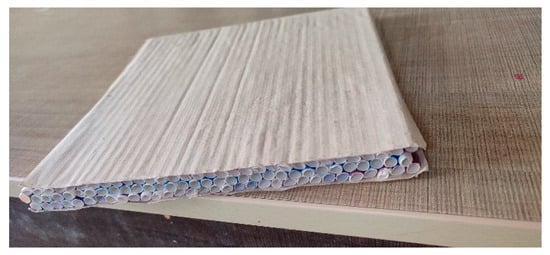
Figure 9.
Experimental setup of the triple layer.
7. Results and Graph
7.1. Cardboard Material
At first, the usual cardboard was subjected to a compression test. Before undergoing compression, its thickness was 4.4 mm. After applying the load, it became 3.7 mm. It could withstand up to 5.5 kN. The result was graphed and is shown in Figure 10.
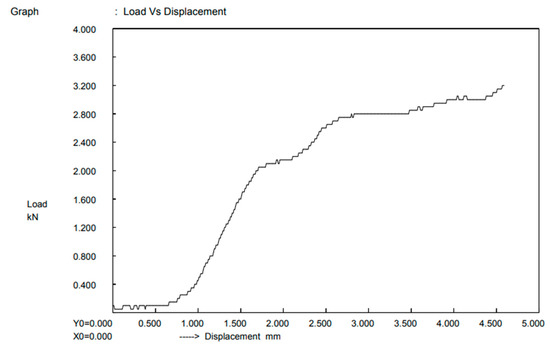
Figure 10.
Load vs. Displacement for traditionally used cardboard.
7.2. Single-Layer
The real model went through a compression testing machine with a dimension of 5 mm. The load was applied gradually to the one-layer model. It could withstand up to 5.6 kN. After compression, it was slightly deformed. The dimension after undergoing compression was 4.8 mm, and the readings were graphed and are shown in Figure 11.
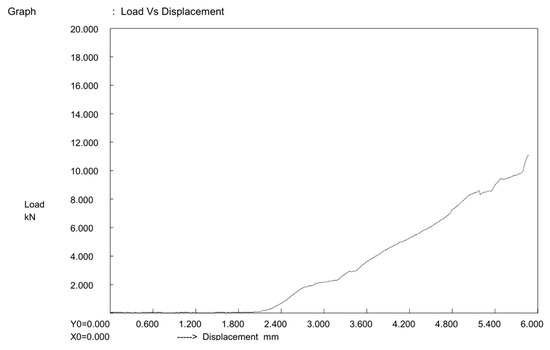
Figure 11.
Load vs. Displacement for single-layer experimental setup.
7.3. Double-Layer
Then, we used two layers for compression testing. The thickness before undergoing the compression test was 10 mm. It could withstand up to 6.2 kN. After reloading it, the thickness became 9.1 mm, which is considerably stronger than the single-layer one. Thus, the double layer produces a cushioning effect (shown in Figure 12).
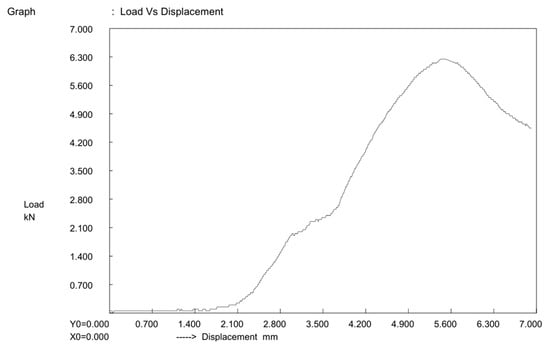
Figure 12.
Load vs. Displacement for the two-layer experimental setup.
7.4. Triple-Layer
Then, we used three layers for compression testing. The thickness before undergoing the compression test was 15 mm. It could withstand up to 11.10 kN. After reloading it, the thickness became 14. 9 mm, which is considerably stronger (shown in Figure 13).
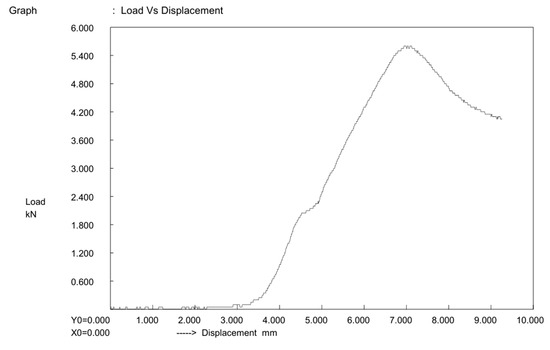
Figure 13.
Load vs. Displacement for the three-layer experimental setup.
8. Manufacturing Considerations and Cost Analysis
The process involves cutting kraft paper with precision tools, rolling it into cylinders, and securing them with eco-friendly adhesives or locks. Cylinders are stacked in a pentagonal arrangement using automated tools or jigs for accuracy. Automated rolling mechanisms and robotic systems ensure consistency and precise assembly. Biodegradable adhesives enhance sustainability. Quality checks include compression tests and dimensional inspections. Costs are reduced by using recycled kraft paper and minimizing waste. The design considers manufacturing feasibility, cost comparison, and lifecycle costs, factoring in long-term performance, durability, and recyclability. Kraft paper was selected for its affordability and eco-friendliness, compared to foam. Material data were customized in CAD simulations to ensure cost-effective modeling. The study assessed the production capacity and ease of manufacturing of the cylindrical structures, confirming that large-scale production could be achieved without significant cost increases. Standard materials like kraft paper help control production costs. Performance tests (compression, impact, and vibration) reduced the risk of damage during transport, indirectly lowering costs. A cost comparison showed the financial advantages of kraft paper over foam, considering both initial and long-term environmental costs.
9. Conclusions
Our design efficiently handles different weights without compromising its structural integrity, ensuring reliable load-bearing performance. Our design adapts to various needs, providing tailored support and protection for different applications. By effectively absorbing impact energy, our design minimizes the risk of damage or injury, enhancing safety and user comfort. Built to last, our design boasts long-lasting durability, capable of withstanding diverse environmental conditions and usage scenarios. We prioritize sustainability by using eco-conscious materials and optimizing manufacturing processes to minimize environmental impact. Overall, our design surpasses triangular and hexagonal designs in efficiency, offering superior performance across various metrics including load-bearing capacity, customization options, energy absorption, durability, and sustainability. Made from kraft paper, this design is eco-friendly, renewable, biodegradable, and recyclable, unlike foam materials that cause pollution and decomposition challenges. Kraft paper’s lightweight nature reduces transportation energy costs and emissions. Its flexibility and tear resistance simplify manufacturing, maintaining durability while supporting sustainability. This design combines cylindrical flutes with multilayer stacking, addressing limitations of traditional triangular and honeycomb structures. Cylindrical flutes provide uniform stress distribution, high strength-to-weight ratio, and simple manufacturing, offering a cost-effective and efficient alternative to complex or edge-stress-prone designs.
Author Contributions
Conceptualization and methodology, A.P.M.; Writing—original draft preparation, S.K., and A.D.; Testing and data collections, P.P. and B.P.S.; Review and editing, P.P., and B.P.S.; Supervision, A.P.M. All authors have read and agreed to the published version of the manuscript.
Funding
This research received no funding.
Institutional Review Board Statement
Not applicable.
Informed Consent Statement
Not applicable.
Data Availability Statement
Data are contained within this article.
Acknowledgments
The authors wish to acknowledge that this research was conducted without any external funding or support. This research work was carried out at SASTRA Deemed University, Thanjavur, Tamil Nadu, India. We extend our gratitude to the SASTRA University for providing the necessary infrastructure and environment for this research work.
Conflicts of Interest
The researchers declare no conflicts of interest related to this study. All authors adhered to ethical guidelines and have no financial or personal ties that could bias the research.
References
- Sek, M.; Rouillard, V.; Tarash, H.; Crawford, S. Enhancement of cushioning performance with paperboard crumple inserts. Packag. Technol. Sci. Int. J. 2005, 18, 273–278. [Google Scholar] [CrossRef]
- Allaoui, S.; Aboura, Z.; Benzeggagh, M.L. Effects of the environmental conditions on the mechanical behaviour of the corrugated cardboard. Compos. Sci. Technol. 2009, 69, 104–110. [Google Scholar] [CrossRef]
- Naganathan, P.; He, J.; Kirkpatrick, J. The effect of compression of enclosed air on the cushioning properties of corrugated fibreboard. Packag. Technol. Sci. Int. J. 1999, 12, 81–91. [Google Scholar] [CrossRef]
- Aboura, Z.; Talbi, N.; Allaoui, S.; Benzeggagh, M.L. Elastic behavior of corrugated cardboard: Experiments and modeling. Compos. Struct. 2004, 63, 53–62. [Google Scholar] [CrossRef]
- Frank, B. Corrugated box compression—A literature survey. Packag. Technol. Sci. 2014, 27, 105–128. [Google Scholar] [CrossRef]
- Biancolini, M.E.; Brutti, C. Numerical and experimental investigation of the strength board packages. Packag. Technol. Sci. 2003, 16, 47–60. [Google Scholar] [CrossRef]
- Garbowski, T.; Gajewski, T.; Grabski, J.K. The role of buckling in the estimation of compressive strength of corrugated cardboard boxes. Materials 2020, 13, 4578. [Google Scholar] [CrossRef] [PubMed]
- Singh, J.; Olsen, E.; Singh, S.P.; Manley, J.; Wallace, F. The effect of ventilation and hand holes on loss of compression strength in corrugated boxes. J. Appl. Packag. Res. 2008, 2, 227. [Google Scholar]
Disclaimer/Publisher’s Note: The statements, opinions and data contained in all publications are solely those of the individual author(s) and contributor(s) and not of MDPI and/or the editor(s). MDPI and/or the editor(s) disclaim responsibility for any injury to people or property resulting from any ideas, methods, instructions or products referred to in the content. |
© 2025 by the authors. Licensee MDPI, Basel, Switzerland. This article is an open access article distributed under the terms and conditions of the Creative Commons Attribution (CC BY) license (https://creativecommons.org/licenses/by/4.0/).